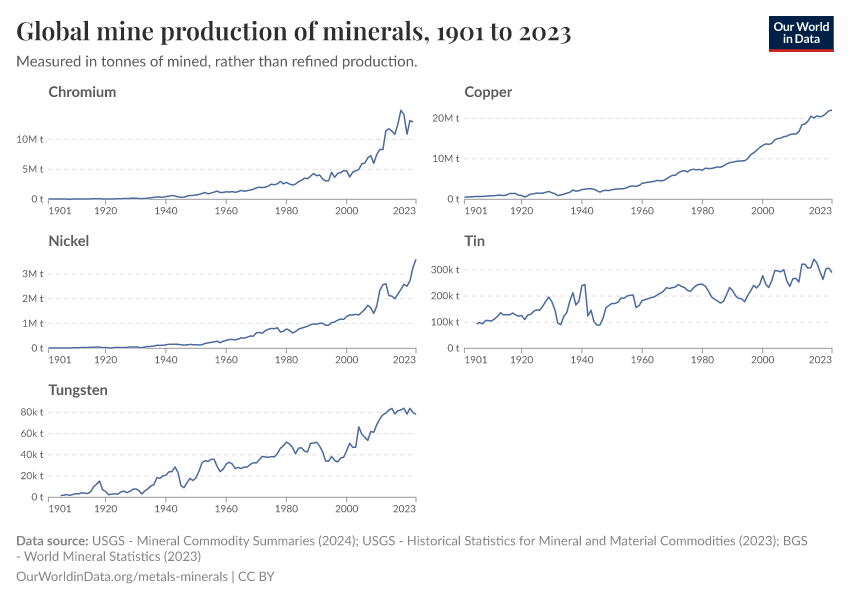Global mine production of minerals

What you should know about this indicator
- Antimony - Values are reported as tonnes of metal content.
- Asbestos - Values are reported as gross weight.
- Bismuth - Values are reported as tonnes of metal content. Values are reported as tonnes of metal content.
- Chromium - Values are reported as tonnes of contained chromium.
- Gemstones - Values are reported as tonnes of gemstone-quality diamonds.
- Graphite - Values refer to natural graphite.
- Lithium - Values are reported as tonnes of lithium content.
- Platinum group metals (iridium) - Values are reported as tonnes of metal content.
- Platinum group metals (other) - Values are reported as tonnes of metal content.
- Platinum group metals (rhodium) - Values are reported as tonnes of metal content.
- Potash (chloride) - Values are reported as tonnes of potassium oxide content.
- Potash (polyhalite) - Values are reported as tonnes of potassium oxide content.
- Potash (potassic salts) - Values are reported as tonnes of potassium oxide content.
- Potash - Values are reported in tonnes of potassium oxide equivalent.
- Rare earths - Values are reported in tonnes of rare-earth-oxide equivalent.
- Titanium (ilmenite) - Values are reported as tonnes of titanium dioxide content.
- Uranium - Values are reported as tonnes of metal content.
Sources and processing
This data is based on the following sources
How we process data at Our World in Data
All data and visualizations on Our World in Data rely on data sourced from one or several original data providers. Preparing this original data involves several processing steps. Depending on the data, this can include standardizing country names and world region definitions, converting units, calculating derived indicators such as per capita measures, as well as adding or adapting metadata such as the name or the description given to an indicator.
At the link below you can find a detailed description of the structure of our data pipeline, including links to all the code used to prepare data across Our World in Data.
Notes on our processing step for this indicator
- The majority of the data is sourced from USGS, supplemented by BGS data where available. Where both overlap, USGS data is prioritized.
- As BGS does not provide global data, we calculated the world total by summing the data from individual countries, using this as a cross-check against USGS global figures.
- Due to the inherent uncertainties in the data for certain minerals and countries, we allowed a maximum deviation of 10% between the global totals reported by USGS and the calculated ones for BGS. If the deviation exceeded this threshold, we excluded the BGS data.
- The calculated global total from BGS data was used only on exceptional occasions, after ensuring that the resulting aggregate was sufficiently complete.
- Both BGS and USGS datasets include numerous notes and footnotes. We have retained most of these, making only minor edits or deletions where necessary to maintain clarity.
Reuse this work
- All data produced by third-party providers and made available by Our World in Data are subject to the license terms from the original providers. Our work would not be possible without the data providers we rely on, so we ask you to always cite them appropriately (see below). This is crucial to allow data providers to continue doing their work, enhancing, maintaining and updating valuable data.
- All data, visualizations, and code produced by Our World in Data are completely open access under the Creative Commons BY license. You have the permission to use, distribute, and reproduce these in any medium, provided the source and authors are credited.
Citations
How to cite this page
To cite this page overall, including any descriptions, FAQs or explanations of the data authored by Our World in Data, please use the following citation:
“Data Page: Global mine production of minerals”. Our World in Data (2025). Data adapted from United States Geological Survey, British Geological Survey. Retrieved from https://wdi-citations.owid.pages.dev/grapher/global-mine-production-minerals [online resource]How to cite this data
In-line citationIf you have limited space (e.g. in data visualizations), you can use this abbreviated in-line citation:
USGS - Mineral Commodity Summaries (2024); USGS - Historical Statistics for Mineral and Material Commodities (2023); BGS - World Mineral Statistics (2023) – with major processing by Our World in DataFull citation
USGS - Mineral Commodity Summaries (2024); USGS - Historical Statistics for Mineral and Material Commodities (2023); BGS - World Mineral Statistics (2023) – with major processing by Our World in Data. “Global mine production of minerals” [dataset]. United States Geological Survey, “Mineral Commodity Summaries”; United States Geological Survey, “Historical Statistics for Mineral and Material Commodities”; British Geological Survey, “World Mineral Statistics” [original data]. Retrieved March 12, 2025 from https://wdi-citations.owid.pages.dev/grapher/global-mine-production-minerals